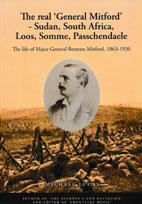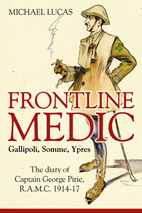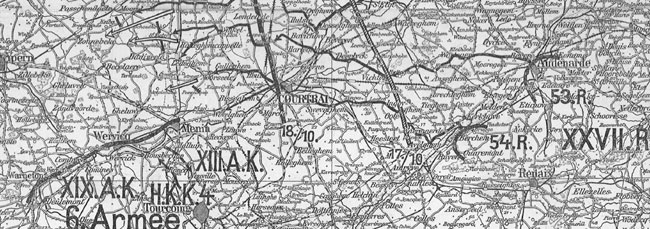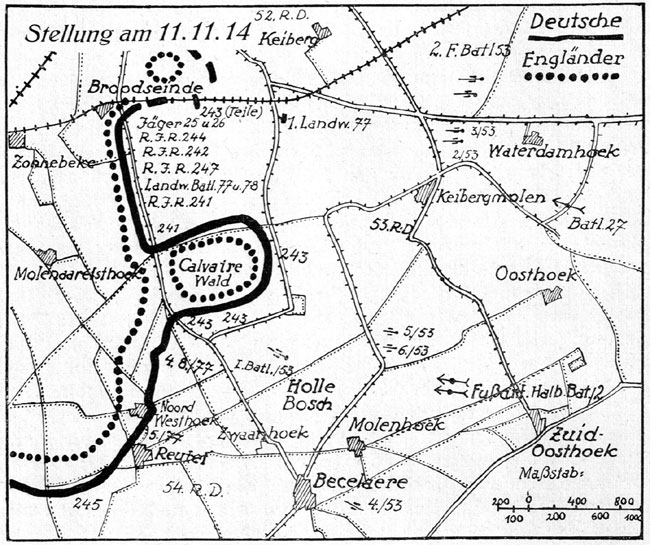Extracts from von Heygendorff's private diary were later provided by his widow and surviving son to the regimental veterans' association and serialised in 'Was wir erlebten'. Written at the time and seemingly neither edited nor intended for publication, these entries provide a shockingly frank and immediate account of the chaotic situation he faced upon taking command of RIR 245.
On 20th October 1914 the regiment had stormed the village of Becelaere (Beselare) alongside Württemberg RIR 246, but rapidly became bogged down in costly attempts to take the British positions beyond (toward Polygon Wood). Cohesion was lost, and the intermingled German units in Becelaere suffered severely from British and misdirected German artillery fire. The many casualties included the original commander of RIR 245. Oberst z.D. Karl Artur Baumgarten-Crusius had survived personally leading the assault on the 20th only to be wounded by (purportedly) a German shell on the 21st. Invalided out of service with the honorary (charakterisiert) rank of Generalmajor, he would become one of the most prolific historians of the Royal Saxon Army and co-author of its three-volume quasi-official history Sachsen in Grosser Zeit.
By the time the Kriegsministerium in Dresden had dispatched Major von Heygendorff to assume command of RIR 245 on 23rd October, the regiment had also lost two of its three battalion commanders. Worse still for the 54.RD, its solitary brigade commander Württemberg Genltn. a.D. Karl von Reinhardt had been killed by a stray bullet on the 22nd while visiting the lines of RIR 245.
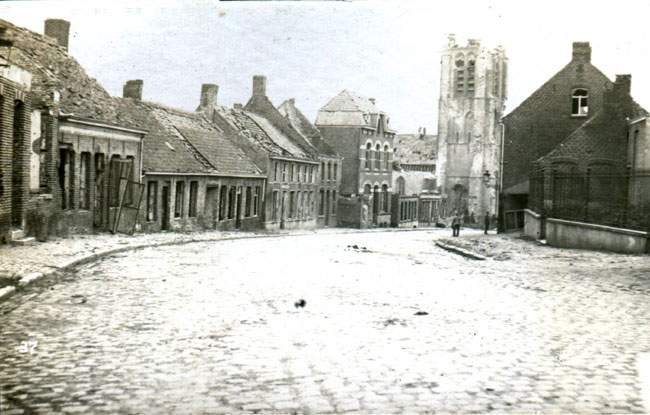
Above: Although subjected to prolonged and intense attention from British (and sometimes German) artillery during the First Battle of Ypres, the village of Becelaere was still surprisingly intact in 1915. Most of the artillery fire had been shrapnel, ruinous to windows and slates but no threat to the structural integrity of brick buildings.
After its capture by 54. Reserve-Division on 20th October the church (right) was pressed into use as a dressing station. On the 25th several heavy shells penetrated the roof, causing hideous carnage among the helpless stretcher cases crowded inside. Two stretcher-bearers were killed and three wounded during the desperate rescue operation. Vizefeldwebel Erich Kühn of RIR 244, another of our featured diarists in Fighting the Kaiser’s War, was among those whose lives were saved.
24 October
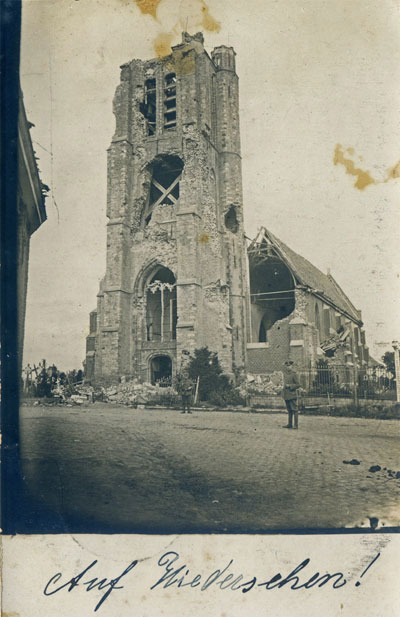
We travel right through the night. There is no thought of sleep. The route goes via Maubeuge and into Belgium between Ostend and Ghent. In Tielt we report to the AOK, where we learn that our Reservekorps - four have been formed - are not advancing due to a lack of active leadership, the dreadful losses taken immediately upon entering the battle and their composition from Landwehr and war volunteers. ...
We proceed to Dadizeele and report to the Generalkommando (General v. Carlowitz). I am appointed regimental commander of RIR 245, belonging to the 54. (Württemb.) Division (Exz. v. Schäfer) and then head off to find my regiment, which has been scattered and engaged in combat since Monday (today is Saturday). In Becelaere I meet the acting brigade commander Oberst v. Roschmann [RIR 246], who briefs me but emphasises the hopelessness of the situation. So now I'm standing here in the town with no troops (they are out in front, I. Batl. is detached), no horses (they are swimming in northern France), no baggage (it was left at the Generalkommando), no nosebag (my orderly has disappeared with it), no billet and no hope. The street is teeming with stragglers from all regiments, who have come out of the trenches to fetch some food (as they have received nothing since Monday) or to bring in the wounded (which they are not authorised to do for themselves). I search them out in the houses and cellars. The complaint is always: we have no leaders and no food. ... Finally I have 1 ½ platoons together and deploy them behind the village, since the place is coming under a great deal of artillery fire.
25 October
The fun lasted until 2am, then I laid down deathly tired on the bed in the brigade guardhouse. Crazy rifle fire during the night. ... The next morning I insist that my II. Batl. (v. Wachsmann) be put back at my disposal, so that I can relieve the forward firing line and get my sub-units in order. Around midday the regimental adjutant Ltn. Bachmann and battalion adjutant Ltn. Wienicke turn up, having spent three days stuck in a house with the English lying only 30 metres away. They managed to sneak past. I gather that the [previous] regimental commander Oberst Baumgarten [-Crusius] is wounded, the battalion commander Oberstltn. Haeser [I./245] has fallen and Oberst Hesse [III./245] is wounded. As v. Wachsmann [II./245] and his officers are receiving orders from me, a shell strikes the house. Splinters fly everywhere. And now a bombardment is let loose which beggars all description. There are surely spies there who have betrayed our position, as the most frenzied fire is directed at the staff quarters. I have destroyed a telephone line, had a windmill burned and cut the guyropes of a factory with wind catchers which struck me as suspicious. Naturally we relocate. About 5pm I receive an order to advance with my 'reserves' as protection for the artillery deployed to our north, because the 53. Reserve-Division fighting on our right is retreating from an English breakthrough. Thank God our heavy artillery shoots exceptionally well and commits no fratricide. The breakthrough fails. I would have been unable to do anything about it, since I have only found about 30 men. I go back home. The relief takes place. Around 1am I have the I. and III. Batl. together, in total 350 men! Major Franz has also been sent to me – now despite it all there is some sort of order. Torrential rain.
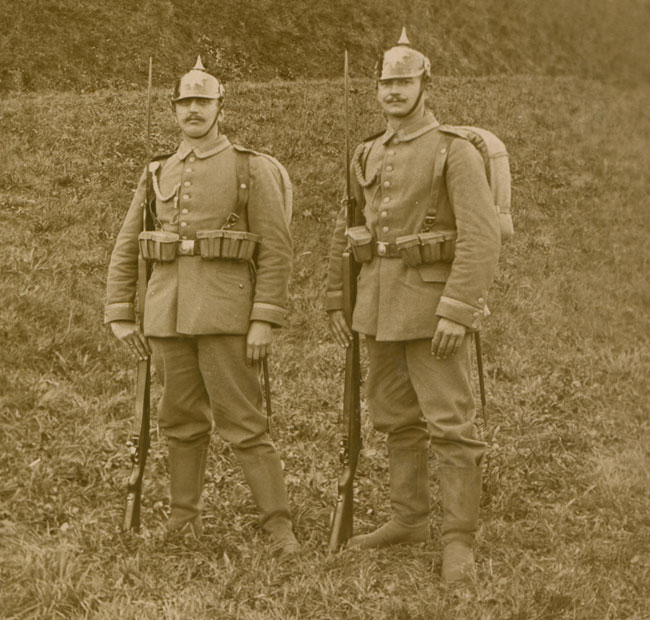
Above: One of these two corporals (we do not know which) photographed at Zeithain before the regiment’s departure for Flanders is Unteroffizier der Landwehr Arthur Bertram of 11. Komp. / RIR 245. Born at Hohenfichte near Flöha, Bertram is recorded as ‘lightly’ wounded in the initial fighting of 21st-24th October 1914.
RIR 245 was officially formed in Leipzig on 25th August 1914, part of a huge wave throughout Germany of new reserve units beyond those allowed for in the mobilisation plans. While a likely majority of the new regiment’s enlisted men were previously untrained supplementary reservists (Ersatz-Reservisten) or young war volunteers (Kriegsfreiwillige), its NCOs were - by necessity - drawn mainly from the older categories of trained reservists. Many of the officers were ‘dug-outs’ from retirement (außer Dienst) or semi-retirement (zur Disposition), including the regimental commander and all three battalion commanders.
Like countless other units of all arms serving with the XXII., XXIII., XXVI. and XXVII. Reservekorps, RIR 245 received a drastically accelerated training program (much hampered by equipment shortages) during September and early October before being rushed with indecent haste into the Flanders offensive. The human cost of this desperate strategic gamble proved to be staggering.
- << Prev
- Next



